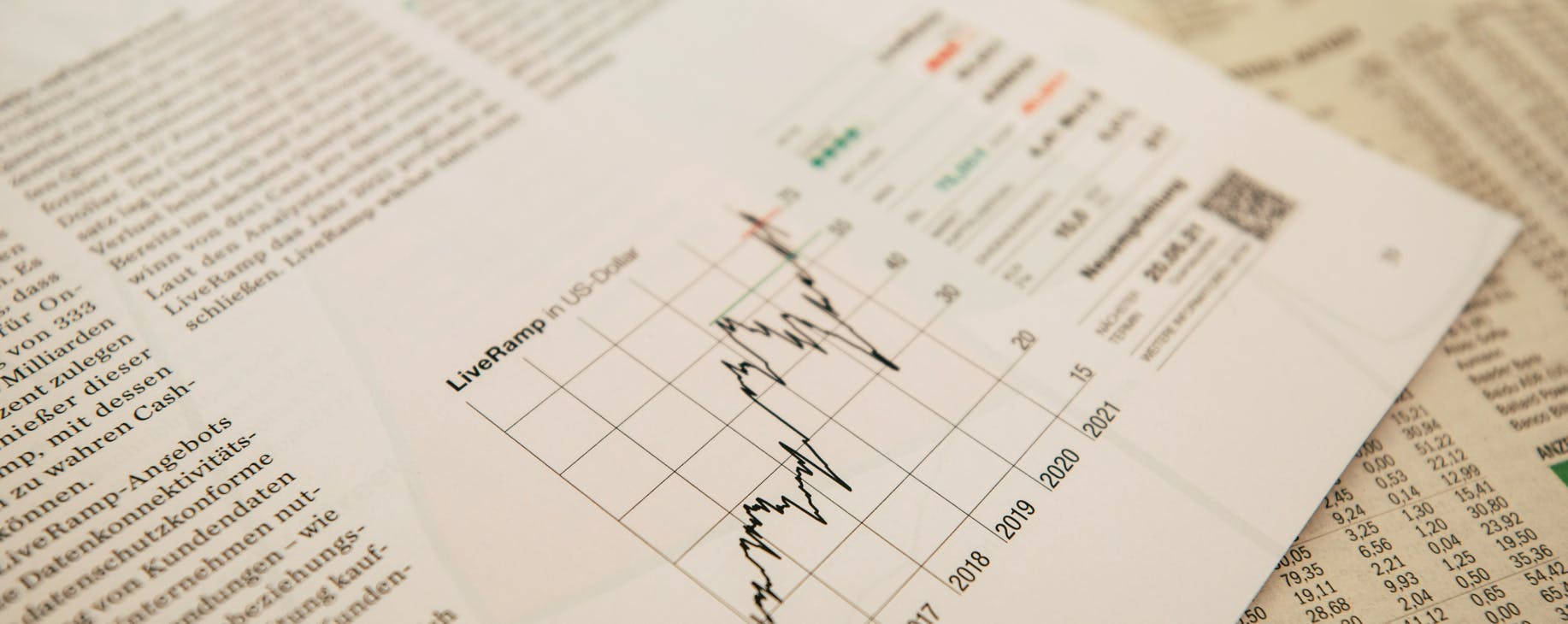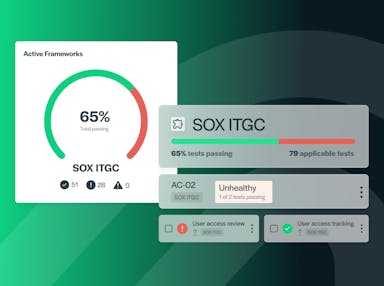
SOX ITGCs: How to Choose IT General Controls for SOX Requirements
Emily Bonnie
Senior Content Marketing Manager
Cavan Leung
Senior Compliance Manager
If your company is publicly traded or planning an IPO, you’re likely already familiar with the Sarbanes-Oxley Act (SOX). Enacted in 2002 in response to high-profile accounting scandals, SOX was designed to protect investors by improving the accuracy and reliability of corporate disclosures.
At its core, SOX compliance is about ensuring the integrity of financial reporting. And in today’s digital landscape, that means securing the systems that store, process, and report financial data. SOX IT General Controls (ITGCs) are designed to do just that.
But there’s a catch: SOX doesn’t specify a checklist of required controls. Instead, it mandates organizations scope, select, implement, and monitor their own controls based on their unique environment, risks, and systems.
That flexibility can be empowering, but it can also be overwhelming. This guide will walk you through what SOX ITGCs are, how to choose and implement the right ones for your organization, and how automation can streamline your efforts and keep your information security controls operating effectively.
What are SOX IT General Controls?
Information Technology General Controls (ITGCs) are foundational IT policies and procedures that help ensure the integrity, confidentiality, and availability of systems that impact financial reporting. These controls form a critical part of your organization’s internal control over financial reporting (ICFR), which is required under Section 404 of SOX.
While SOX doesn’t explicitly define ITGC requirements, auditors commonly assess these controls as part of their review of your internal controls over financial reporting.
These security controls apply broadly across IT systems and environments and ensure that the sensitive data used in financial reporting can be trusted. SOX ITGCs typically fall into the following control areas:
| Control Area | Example Application Controls |
|---|---|
| Access Management | User account provisioning and deprovisioning, least privilege, multifactor authentication, periodic user access reviews, privileged access permissions |
| Change Management | Change request and approval processes, segregation of duties, change documentation, version control, rollback procedures |
| Backup & Recovery | Scheduled data backups, backup encryption, recovery testing, offsite storage, disaster recovery plan |
| System Operations | Job scheduling, error handling, monitoring of system logs, incident response, system uptime and maintenance |
| Logical Security | Firewall configuration, endpoint protection, vulnerability scanning, patch management, secure configuration baselines |
| Physical Security | Restricted physical access to servers and data centers, visitor logs, environmental controls |
| IT Governance | Defined roles and responsibilities, IT risk assessments, formalized IT policies and procedures |
| Third-Party Management | Vendor risk assessments, SLAs with control requirements, third-party system monitoring |
| Data Integrity & Availability | Data classification, encryption at rest and in transit, redundancy, high availability infrastructure |
Recommended reading

What is SOX Compliance? How To Meet Key Requirements And Avoid Penalties in 2025
How to select and implement SOX ITGCs
Choosing the right SOX ITGCs requires more than referencing a universal checklist. You need to understand your business processes, systems, and risk profile to ensure that your controls are effective and audit-ready.
Here’s a step-by-step guide to help you scope, select, and implement the right controls.
Step 1: Define the scope of SOX-relevant systems
Scoping is the foundation of effective SOX ITGC selection. You’re not trying to secure every system in your IT environment, only those that impact financial reporting.
Start by mapping out your financial reporting process: what data is collected, how it flows through information systems, and what applications and infrastructure support it. Your finance, accounting, and IT teams should work together to build a data flow diagram or system inventory.
Look for:
- Systems directly involved in financial reporting, such as general ledger, ERP, payroll, and financial consolidation tools
- Systems that feed data into financial reports, such as procurement, billing, and revenue recognition
- Infrastructure that supports those systems, such as databases, cloud platforms, and authentication services
A good rule of thumb: if a system processes, stores, or transmits financial data, or if its failure or compromise could result in inaccurate financial statements, it’s likely in scope.
Document all in-scope systems and components in a centralized inventory. Include system owners, dependencies, data types, and the specific financial reports they impact.
Step 2: Identify risks
Once your scope is defined, the next step is to identify potential risks to the confidentiality, integrity, and availability of the systems and data within it.
Start with risk management workshops or interviews with system owners and SMEs. Then, analyze your systems for common SOX-relevant risk categories, including:
- Unauthorized access
- Inadequate change control
- Loss or corruption of financial data
- Unmonitored or unresolved system errors
- Downtime during reporting periods
- Weak vendor controls on cloud or SaaS environments
Document risks in a risk register. This ensures full traceability when mapping risks to controls later and makes SOX compliance audits significantly easier. Here’s an example of a risk register with the specific details to include, listed in the first row:

Step 3: Select appropriate ITGCs
This is where you align your identified risks with specific controls. Two key frameworks can help: COSO and COBIT.
- COSO is the most widely used framework for internal control over financial reporting. It provides five core components (control environment, risk assessment, control activities, information and communication, monitoring) and 17 principles.
- COBIT (Control Objectives for Information and Related Technologies) is an IT governance framework developed by ISACA. It’s highly detailed and maps specific IT processes to control objectives.
To guide your selection of IT general controls for SOX compliance, start by using the COSO framework as your foundation. COSO outlines the principles of effective internal control over financial reporting, which align directly with the expectations of Section 404. Each risk you’ve identified should be mapped to one or more of these principles to ensure your ITGCs support broader compliance and governance objectives.
Once you’ve mapped risks to COSO principles, turn to the COBIT framework to help define the technical implementation of your controls. COBIT provides detailed control objectives and best practices specific to IT processes. For example, where COSO might require appropriate access controls for financial systems, COBIT includes control objectives like DSS05.04, which outlines how to manage user identities and logical access. This allows you to translate high-level control goals into concrete, actionable procedures tailored to your IT environment.
As you define your controls, make sure they’re appropriate for your organization’s size, infrastructure, and complexity. A control that works in a highly segmented, on-premises environment may be too complex or irrelevant in a lean, cloud-native setup. Focus on selecting controls that are not only effective on paper but are also practical to implement and maintain within your existing systems and workflows.
Step 4: Document control procedures
Well-documented controls are critical for both effectiveness and SOX audit readiness. Documenting these elements upfront ensures accountability, simplifies audits, and supports consistent, reliable monitoring over time.
Each control should have a written procedure that includes:
- Control name and ID
- Purpose of the control
- Risk(s) addressed
- Systems and data affected
- Control owner and/or responsible team
- Control activity description
- Frequency (real-time, daily, weekly, quarterly, annually)
- Evidence requirements
- Method of testing or verification
Internal auditors can use a centralized GRC platform or compliance management system to maintain IT control documentation, version history, and testing results.
Step 5: Test and validate control performance
Before your external auditor tests your SOX controls, you should review controls by performing your own control testing. This internal audit helps catch issues early and strengthen your overall audit posture.
Testing methods include:
- Inquiry: Asking relevant personnel about processes or controls, should be corroborated with evidence
- Observation: Watch the control in action and verify that it operates as documented in real time
- Reperformance: Recreate the control activity using the same inputs to confirm outcomes
- Inspection: Review artifacts, logs, or evidence to confirm that the control was executed
Focus first on high-risk controls and any that have had issues in the past. If something doesn’t pass your testing, take the time to document what went wrong, why it happened, and what mitigation actions you’re taking to fix it. Be sure to keep a clear record of your test results and any follow-up actions to maintain a clean audit trail.
Recommended reading

Secureframe Introduces Comprehensive Support for SOX ITGC
How to monitor SOX controls with automation
Once your ITGCs are up and running, you’ll need to make sure they continue to operate effectively all year long — not just during audit season. That’s where automation can make a real difference, reducing manual effort while increasing confidence in your controls.
Modern compliance automation platforms can integrate with your cloud infrastructure, identity providers, and ticketing systems to continuously monitor controls and pull real-time data. They can map your existing configurations to SOX compliance requirements, automatically flag failures or misconfigurations, and provide alerts with actionable remediation guidance. They also track and log control performance so you’re always audit-ready.
Secureframe does all of this, and more.
- Automated evidence collection: With hundreds of deep integrations, Secureframe automatically collects and maps audit-ready evidence against SOX ITGC requirements, eliminating manual work.
- Customizable policy library: Access policy and process templates developed by compliance experts and former auditors, or customize policies to align with your organization’s objectives.
- Continuous monitoring: Secureframe integrates with your tech stack to monitor for failing controls, misconfigurations, and compliance gaps, ensuring ongoing compliance and minimizing risks.
- Tailored remediation guidance: AI-powered workflows identify and resolve vulnerabilities and compliance gaps quickly with customized recommendations for control remediation.
- Control mapping: Map your ITGC controls across 40+ frameworks to simplify regulatory compliance with other frameworks, including NIST 800-53, NIST 800-171, CMMC, HIPAA, and GDPR, as well as commercial cybersecurity standards like SOC 2, ISO 27001, and Microsoft SSPA.
- Third-party risk management: Use AI-powered risk assessments and automated monitoring to identify, assess, and mitigate vendor risks that could impact your SOX ITGC compliance.
- Access management: Simplify user access reviews and vendor access monitoring to prevent unauthorized access.
- Centralized compliance management: View and manage SOX ITGC controls in a single, unified dashboard, with the ability to assign control owners and track remediation progress.
See why 95% of Secureframe users say our platform helps them achieve compliance faster and more efficiently by scheduling a demo with a product expert.
Automate compliance
FAQs
What are SOX ITGC controls?
SOX ITGC controls, or Sarbanes-Oxley IT General Controls, are foundational IT controls that help ensure the integrity, security, and accuracy of financial data. These controls support compliance with the Sarbanes-Oxley Act by governing how financial systems are managed and accessed. They typically cover areas like user access, system changes, data backups, and IT operations to ensure that financial reporting is reliable and tamper-proof.
What are the 4 domains of ITGC?
The four core domains of IT General Controls (ITGC) under SOX are:
- Access to Programs and Data: Ensuring only authorized users can access sensitive systems and information.
- Program Changes: Controlling and documenting changes to software applications and systems.
- Program Development: Applying structured processes to develop or acquire new systems and applications.
- Computer Operations: Managing day-to-day IT operations, including data backups, batch processing, and system monitoring.
Together, these domains form the foundation for secure and compliant IT environments that support accurate financial reporting.
What is a SOX audit?
A SOX audit is a formal evaluation of a company’s internal controls over financial reporting, as required by the Sarbanes-Oxley Act of 2002. The audit assesses whether these controls are effectively designed and operating as intended to prevent errors, fraud, or misstatements in financial statements. It often includes a review of both financial and IT processes, especially ITGCs, to verify that financial data is secure, accurate, and properly managed.
What does SOX mean in cybersecurity?
SOX refers to the controls and practices companies must implement to protect the confidentiality, integrity, and availability of financial data. While SOX isn't a cybersecurity regulation in the traditional sense, it does require organizations to secure systems involved in financial reporting. This means applying cybersecurity best practices like access controls, logging, encryption, and monitoring to ensure financial data isn’t altered, deleted, or accessed inappropriately.
What are the three types of SOX controls?
SOX controls typically fall into three categories:
- Preventive controls – Designed to stop errors or fraud before they happen (e.g., role-based access controls).
- Detective controls – Help identify issues after they’ve occurred (e.g., audit logs, system alerts).
- Corrective controls – Address and fix identified issues to prevent recurrence (e.g., patch management, incident response plans).
These control types work together to ensure the security and integrity of financial reporting systems and data.

Emily Bonnie
Senior Content Marketing Manager
Emily Bonnie is a seasoned digital marketing strategist with over ten years of experience creating content that attracts, engages, and converts for leading SaaS companies. At Secureframe, she helps demystify complex governance, risk, and compliance (GRC) topics, turning technical frameworks and regulations into accessible, actionable guidance. Her work aims to empower organizations of all sizes to strengthen their security posture, streamline compliance, and build lasting trust with customers.

Cavan Leung
Senior Compliance Manager
Cavan Leung, CSSK, CISA, CISSP is an information security leader with over a decade of experience in the security, privacy, and compliance industries. A former auditor and security consultant, Cavan performed ERP and SOX compliance audits at Deloitte, as well as SOC 1, SOC 2, GDPR, and ISO 27001 compliance assessments for Fortune 500 companies at Schellman. At Secureframe, he’s helped hundreds of customers achieve compliance with SOC 2, ISO 27001, GDPR, HIPAA, and more.